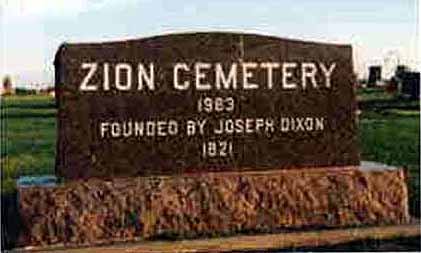Joseph Harrison Dickson, Illinois Fur Trader
Joseph Dickson was a fur trader mentioned in the Lewis and Clark journals in July 3, 1806. Dickson and Forrest Hancock were the first American traders to go up the Missouri after Lewis and Clark. They received advice and supplies from Lewis and Clark on hunting near the Yellowstone region. Joined by Private John Colter from the expedition, they headed upriver on August 15.
Joseph Harrison Dickson was born January 15, 1775 in Cumberland County, Pennsylvania. He grew up there and married an Irish immigrant named Susan in 1798. He moved to Jefferson County, Tennessee. His two eldest children were born there in 1799 and 1801. They raised a total of nine children.
In 1802 he moved with his wife and two children to Cahokia, St. Clair County, Illinois. They settled in the American Bottom, in a place then known as Turkey Hill. Dickson earned money cutting timber and trapping for fur. He met future partner Forest Hancock on the Gasconade River while logging. Hancock had come to settle in Missouri with Daniel Boone three years earlier. Through Hancock’s Boone connection, he learned about the Lewis and Clark Expedition. The two decided to go up the Missouri to make their fortune trapping.
They started out in August of 1804 and spent the winter near what is now Sioux City, Iowa. They trapped furs and cached them, but their cache was stolen. The next spring they joined Charles Courtin’s trapping group and wintered at a camp of Teton Sioux. This effort, too, was ill-fated, as the Sioux robbed them, and Dickson was wounded in a fight.
The pair met Clark at the Little Knife Creek camp on August 11, 1806. Dickson and Hancock met Lewis the next day upriver.For about 90 minutes they discussed going upriver to trap beaver. Lewis gave them directions, descriptions, and distances along the river and its tributaries and locations where beaver abounded. They asked Lewis for some powder and lead to replace the stock they used to fight the Sioux. (Lewis, Aug. 12, 1806)
Dickson and Handcock, who may have known John Colter before, asked Lewis for permission for Colter to accompany them upriver to the Yellowstone. Colter also helped gather the supplies at the Mandan camp that the three would need for a year’s trip. The three men set out on August 17, 1806 and traveled some distance up the Yellowstone River. According to Moulton and other sources, they had a falling out. Colter and Hancock went one way, leaving Dickson alone in the Yellowstone for the winter. John Colter would go on to fame as the first “Mountain Man.” The other two traders would not gain fame, but Dickson’s adventures have been described — and even include a tale of a miracle.
According to the legend of this winter stay, either the three men or Joseph alone dug a hole in a sun-facing hillside and wintered there with a store of meat and fuel. (Dickson was back in Illinois by August, 1807 and his son, Missouri, was born May, 1808.) The tale is that Joseph was snow-blinded and doomed to die in the wilderness, but, after praying for help, he felt compelled to make a poultice of the bark of a nearby tree, which restored his sight. He found religion and decided to return to Illinois and settle down. Four of his children were born in Shiloh (north central St. Clair County) from 1808 to 1817. He became active in the Methodist Church.
Joseph Dickson’s dream of making a fortune in fur trading never materialized, but he led a life of adventure like that of many early settlers inIllinois. During the winter months, he hunted on the Gasconade River in Missouri with Joseph Scott, a local gun powder maker. In the summer,s he farmed. In 1818, Dickson sold his Shiloh farm. He moved his family in a wagon to Sangamon County in central Illinois (where Cotton Hill Township is today). They squatted on land at Horse Creek, where he “built the first white man’s cabin.” He farmed in the summers and trapped furs in the winters. Sangamon County land was surveyed in 1821 and offered for sale in 1823. The public land sales records show that he bought and registered a total of 240 acres in 1824, 1825, and 1830:
Legal description |
Section |
Township |
Range |
Meridian |
Date |
County |
Purchase Price |
W2NW |
29 |
14N |
04W |
3 |
08/31/1824 |
Sangamon |
$100 |
E2SW |
20 |
14N |
04W |
3 |
03/31/1825 |
Sangamon |
$100 |
W2SE |
19 |
14N |
04W |
3 |
08/18/1830 |
Sangamon |
$100 |
There is a record of Dickson being sworn in as Justice of the Peace of Sangamon County in 1826, and as an election judge in 1830 and from 1834-36.

Sign at Zion Cemetery, Cotton Hill Township, Sangamon County, Illinois
Susan Dickson died in 1841 and was buried in Zion Cemetery, in Cotton Hill Township. Joseph may have moved in with a daughter in Morgan County, where he died in 1844. He may have been buried at Zion, too. Their grave markers disappeared.
Read a more detailed account at https://home.earthlink.net/~denisedickson/Joseph1775.htm